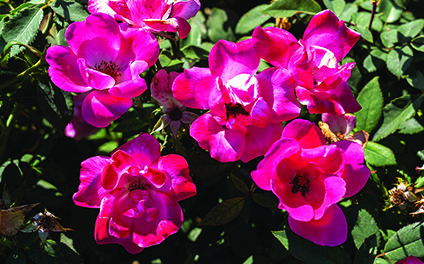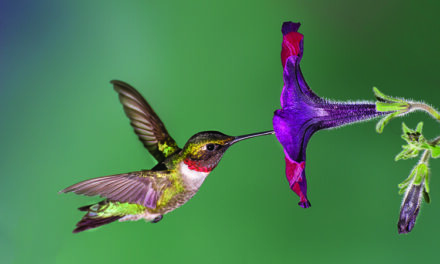
Cut flower gardening with old, dependable favorites such as dahlias is seen as a coming trend for 2022. Floral enthusiasts can enjoy flowers in their gardens and have plenty of flowers to share. (Photos courtesy PHS)
While poring over catalogs of newly released plant introductions this winter, gardeners may be interested in a list of the top six gardening trends for 2022 released by the Pennsylvania Horticultural Society.
Founded in 1827, PHS is the internationally recognized organization while produces the world-famous Philadelphia Flower Show which will be held outdoors for the second year in June.
Andrew Bunting, vice president of Public Gardens and Landscapes at PHS, said “adopting new trends offers gardeners the perfect way to revamp home gardens with new ideas and inspiration, while using gardening to promote year-round health and well-being. This list of garden trends for 2022 is ideal for gardeners of all interests and experience levels to incorporate into their own gardens.”
Bunting himself selects the trends, he explained in a telephone interview, based on trends he sees consistently in travels and conferences. “I go to a lot of botanical gardens and arboretums, as well as private gardens,” he said.
The list is in no particular order.
There’s not one practice that is more a trend than another.
Consider these:
• Utilize Native and Pollinator-Friendly Plants: Bring bees, butterflies and other pollen-loving insects to your gardens! Attracting native pollinators to your garden is a simple way to support the ecosystem from your own backyard. Pollinators are vital to creating and maintaining ecosystems and are crucial to agriculture. Plants such as Pycnanthemum, mountain mint, Echinacea, coneflowers, and Liatris (gayfeather) are all great at attracting these important insects.
• Turn Lawn Space into Garden Space: Did you know lawns are not great for the environment? Even removing a small piece of lawn and transforming it into garden space has the power to significantly lower fossil fuel emissions that would otherwise be applied to the lawn through regular trimming and maintenance. Boost the positive environmental impact by turning lawn into something more productive such as a pollinator garden or vegetable patch. “Anything is more beneficial than a lawn,” Bunting said. “If every homeowner reduced lawn space by just 25 square feet, the compounded amount would be massive.”
• Attend a Plant Swap and Make a New Friend: Connect with fellow gardeners and bring home new plants! A great way to incorporate new plants in your garden and gain expertise as a beginner gardener is through attending a plant swap. At a plant swap, attendees bring their small plants, cuttings, potting soil, pots or other gardening equipment and exchange them for something they don’t have. This is a simple way to diversify your garden, learn new horticultural skills, and connect with fellow gardeners. These meet-and-greet style exchanges are becoming increasingly popular, Bunting said. “We at PHS run many each year in pop up gardens. They attract people of all ages and all walks of life. It’s a great gateway for people to get involved in gardening initially. Locally, Scott Arboretum has the same idea — a members’ plant exchange where members bring 10 plants and take home 10.”
• Try Gravel Gardening, Waterwise Gardening, or Xeriscaping: Not great at regularly watering your garden? You can build a garden with hardy plants and low water requirements. With more and more areas of the country experiencing inconsistent weather patterns and periods of drought, planting gardens that require little watering or irrigation is growing in popularity. Gravel gardening offers just one way to cut back on water requirements, irrigation requirements and fertilizer use in your garden through eliminating the use of soil. Xeriscaping refers to landscaping and gardening in a way that reduces or eliminates the need for irrigation. Gravel gardens and xeriscaping can incorporate a multitude of plants including a wide array of succulents in the Sedum species, as well as Sempervivum tectorum, hens and chicks, hardy cacti such as the Opuntia species, some ornamental grasses, Amsonia hubrichtii, threadleaf bluestar and even yucca. PHS’s own Meadowbrook Farm has already embraced waterwise gardening practices and incorporated many of these species in its gardens.
• Grow Your Own Fruit: With just a little space, you can enjoy your favorite fruits right from your own garden. Growing fruit is no longer reserved for those with orchards. Even just a few fruit trees can produce hundreds of pieces of fruit perfect for jams, jellies, cookies, ice cream or simply eating as-is. Dwarf fruit trees come in many varieties including figs, mulberries, apples and pears, and are ideal for growing with limited space.
• Plant a Cut Flower Garden: Across the United States, boutique flower growers are incorporating more and more classic cut flowers such as zinnia, dahlia, Papaver rhoeas, poppy, Cosmos bippinatus, cosmos and shasta daisy. The return to these timeless varieties of flowers demonstrates a shift away from the more non-traditional, eccentric and often minimalist style common in modern floral arrangements. Cut flowers offer a rewarding means to immerse yourself in horticulture and experience the pride of growing your own flowers and sharing them with loved ones that will surely never go out of style.
Bunting said, “For novice gardeners and expert horticulturists alike, embracing popular garden trends offers an opportunity for inspiration and connection with fellow gardeners.”
PHS offers numerous programs and initiatives to rally community members around a common love for horticulture to positively impact the health and well-being of the Philadelphia region.
“We do this in a multitude of ways,” Bunting said. “We maintain public gardens that are free and accessible to anyone. In the city there’s the
Azalea Garden, Rodin Museum grounds, Sculpture Garden at the Museum of Art, Logan’s Circle and Square, a lot of the Philadelphia Navy Yard and parks along the Delaware River.
“We also have a large tree program. We recently planted 1,300 street trees. And we have a program in which we partner with more than 100 community gardens.”
PHS also turns vacant lots into positive public green spaces in a project known as PHS Philadelphia LandCare. With support from donations and the city, PHS partners with a network of contractors and community groups to clean and green some 300 to 500 vacant lots every year, including demolishing an inhabitable house if necessary. These teams maintain 12,000 green lots around the city.
Other garden trends for the coming year noted online include increased use of natural materials, a focus on sustainability, more permeable paths, gardening for wildlife, organic gardening, succession planting to extend the season, making the most of small outdoor spaces. Whatever your plans for gardening in 2022, enjoy the great outdoors!






